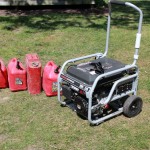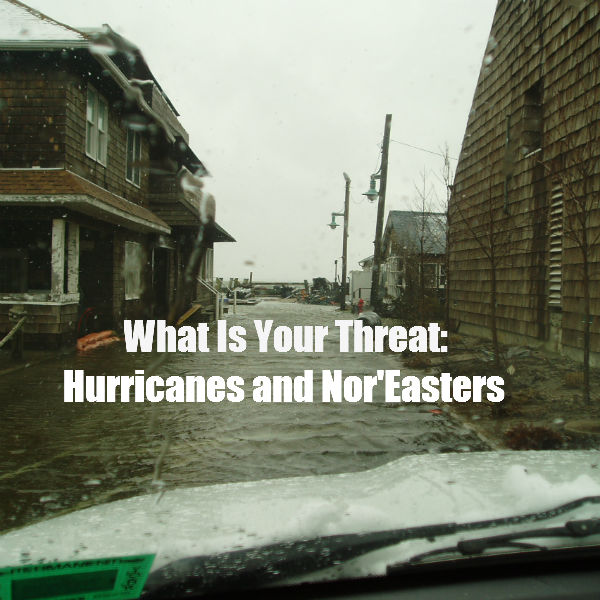The Threat: Hurricanes and Nor’Easters
As a life long resident of Long Island severe Atlantic storms are just a fact of life. Nor’Easters blow through and the occasional Hurricane comes a calling. It is the BIG boys and girls that get etched into our psyche as Long Islanders. Their names become legend Gloria, The Perfect Storm, Irene, The Halloween Storm, and Sandy. They all brought their own special sort of suffering and challenges to over come. The one constant among all of them is that the Preparedness minded folks fared a bit better. By sticking to the Pillars of Preparedness: Food, Water, Shelter, Power, Security, and Community a lot of the stress and difficulties of the big storms can be mitigated.
Hurricanes and Nor’Easters bring high winds, driving rains, and coastal flooding. The 100+ mile per hour winds snap trees and telephone poles like twigs. The torrential rains bring flash flooding which damages roads and backs up sewers. The storm surge floods out low lying areas and entire neighborhoods have washed away in the truly horrific storms. These are the reasons to be prepared!
What can you do about it?
Some well thought out supplies and acquired skills can mean the difference between huddling in the dark wondering where your families next meal is coming from or getting through the disaster in relative comfort and style. By going a bit beyond what Ready.gov is preaching and following the Pillars of Preparedness: Food, Water, Shelter, Power, Security, and Community you will be prepared for those nights when the storm clouds gather and a storm for the record books is brewing.
Food
When it comes to big storms and food, canned and dry goods are the way to go. A reasonable amount of extra food can be squirreled away with out breaking your budget. In the aftermath of Sandy people were dumpster diving for dinner just a few days after the storm hit. The following emergency food ideas aren’t glamorous but they will fill your kids bellies when the power is out and the roads are wrecked. Having an extra week’s worth of food is the minimum to have on hand.
- Canned Soup
- Pasta
- Canned Fruit
- Corned Beef Hash
- Peanut Butter
- Canned Tuna
- Canned Vegetables
- Beef Jerky
- Instant Rice
- Canned Chili
- Granola Bars
Water
The need for a supply of clean water in an emergency situation can’t be talked up enough. When Gloria rolled through in 1985 a lot of Long Island was still on well water. Now I loved the cool and refreshing well water but the problem is no power equals no water! Getting through 10 days in the dark was challenging enough but no running water just added to the misery. Sandy knocked out power all along the South Shore of Long Island and the 5 Boros of New York City. The power outage and high tides combined to completely disable the sewage treatment plants along the shore. This led to 10 billion gallons of raw sewage being released out into the bays and rivers. An immediate order went out to boil drinking water and to avoid swimming, boating, or fishing in the contaminated waters.
- New York City had 6 spills larger than 100 million gallons.
- The Bay Park Treatment plant spewed 100 million gallons of untreated sewage into Hewlett Bay during a 4 hour period and leaked an additional 2.2 billion gallons of partially treated sewage during the next 44 days.
- In 3 weeks after the storm the Passiac River plant oozed 3.8 billion gallons of sewage into the river.
This is why Emergency Water Storage is so important! Shoot for 1 Gallon/day per family member. I like to store water in a variety of containers. I keep a few cases of the common 1/2 liter bottles as well as a few cases of gallons. I rotate through them by either drinking them or grabbing a case and bringing it along to Summer BBQ’s! An extra case of water is always appreciated by a host. I also use Stackable Water Bricks. They store water in an easy to organize system. You don’t even need to keep them filled all the time when it comes to Hurricanes and Nor’Easters just fill a few the days before a big storm rolls through.
Shelter
Unless you live in an area that is affected by the Storm Surge most likely you will be riding out the storm in your home. Have you ever given much thought to what you will do if your home is damaged in a big blow? Now I’m not advocating staying in a house that is obviously dangerous but as we’ve seen time and time again it takes days, weeks, and even months for the Insurance Adjuster and the construction crews to show up. Having some supplies and a plan ahead of time can make a stressful situation a bit easier.
- Tarps
- Duct Tape
- Rolls of clear plastic
- Nails
- Screws
- Some scrap wood
I’m not looking to be able to rebuild civilization here, but being able to keep the wind and rain out will win you points with your spouse and kids!
Power
 If you haven’t gone to bed with the sound of generators humming in the neighborhood you might not live in an area susceptible to Hurricanes and Nor’Easters! My family and I are dirty filthy tent campers so going a few days without power is an inconvenience, it is when the days stretch into weeks that power becomes a genuine concern. For this I turn to a largish portable generator capable of almost powering my entire house. I’ve got it hooked up with a transfer switch and have a long enough cord to put it out in the backyard to minimize the noise.
If you haven’t gone to bed with the sound of generators humming in the neighborhood you might not live in an area susceptible to Hurricanes and Nor’Easters! My family and I are dirty filthy tent campers so going a few days without power is an inconvenience, it is when the days stretch into weeks that power becomes a genuine concern. For this I turn to a largish portable generator capable of almost powering my entire house. I’ve got it hooked up with a transfer switch and have a long enough cord to put it out in the backyard to minimize the noise.
When it comes to living on generator power, fuel is the overriding concern. when the fuel shortage hit during Sandy’s aftermath desperate people turned the gas lines into free-for-all’s where fist fights and road rage became the norm. Because of this I’ve really ramped up my fuel storage and now consider 30 gallons of fuel on hand my absolute minimum.
- Store plenty of fuel.
- Know how to operate your generator.
- Learn how to change the oil and keep enough on hand.
Security
We have been lucky in the Northeast in that our terrible storms have caused devastation but didn’t bring the break downs in civility that Katrina brought to New Orleans. We’ve seen the chaos of the gas lines and generator thefts but wide scale looting and outright pillaging stayed away. For us security has been more about good locks and putting your stuff away at night. Leaving a generator unattended is a good way to wake up to no generator!
- Lock your stuff up when you aren’t going to be around
- A strong chain and a good lock go a long way towards protecting your stuff.
- Lock your gates
- When we were dealing with both Gloria and Sandy siphoning gas out of cars came back into vogue like it was the 70’s all over again. Make sure you secure your vehicle as well!
When it comes to firearms you have to let your conscience and local laws be your guide. Since I live in New York my local conditions would have to swing towards L.A. riots or a Katrina level before I even thought about cracking open my safe.
Community
When I think about all of the big storms that have rolled through my area, what stands out most in my mind is the sense of instant community that they bring with them. As a kid when Gloria whacked us I remember the big multi-family cookouts as we raced to eat through the freezer and playing man-hunt be flashlight. During Irene and Sandy it was throwing extensions cords over fences to share generator power and helping neighbors cut their way out of their driveways with a chainsaw.
Neighbors can be an extra set of eyes while the power is out. Having a close neighbor to venture out to the gas lines with can be comforting. Older neighbors can watch the kids while clean up is going on.
So get to know your neighbors before the big one hits!
The Wrap-Up
Hurricanes and Nor’Easters can be scary. They are big powerful storms that lay waste to hundreds of square miles and tax emergency responders at all levels, having the Pillars of Preparedness in place before they make landfall is key to getting through them in relative comfort and style.
Check out the other “What’s Your Threat?” blogs!

Push Past the Fear and Just Do It!! – Mom with a PREP
Living in Tornado Alley – The Busy B Homemaker
{Forest Fire Safety} – Mama Kautz
Why You Need Food Storage – Food Storage Moms
Break in the Supply Chain – Homestead Dreamer
Economic Downturn – Apartment Prepper
Medical Emergencies at Home – Preparedness Mama
Surviving a Tornado – Survival at Home
Rising Food Prices – Common Sense Homesteading
Economic Collapse – Timber Creek Farms
A Personal Job Loss Situation – Food Storage Made Easy
7 Tips for Keeping Your Family Together in an Emergency – Food Storage & Survival
Massive Blackout– Trailerpark Homestead
How to Overcome a Lack of Motivation to Prepare – Home Ready Home
The Unexpected – Are We Crazy, Or What?
Our Threats Are Many, But Our Worries Are None – Trayer Wilderness
Food Storage Without a Plan – My Food Storage Cookbook
Hurricanes and Nor’Easters – Backyard Pioneer
Hurricanes (What I Wish I Knew Before it Hit!) – Prepared-Housewives
A Financial Disaster – The Surival Mom
Staying Off the Radar – Geek Prepper
Everything Becomes Too Expensive – Beyond Off Grid
Affiliate Disclosure: I am grateful to be of service and bring you content free of charge. In order to do this, please note that when you click links and purchase items, in most (not all) cases I will receive a referral commission. Your support in purchasing through these links enables me to keep the content train rolling







As always thanks for the share. I always joke that I lived in TX for years but was never affected by a Hurricane until we move to Philly.
Irony!
I’d say I’m thankful we don’t get many hurricanes in Toronto, but we had that god-awful power outage this past winter due to an ice storm, so I’m holding my tongue and crossing my fingers that we aren’t riddled by any more natural disasters… at least for the next few years.
I spent the winter of ’98 on the the NY-Canadian border setting poles to clean up from an Ice Storm. Some people were without power for 6 weeks!